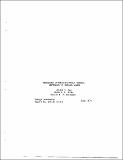| dc.contributor.author | Lee, Joseph Hun-Wei | |
| dc.contributor.author | Jirka, Gerhard Hermann | |
| dc.contributor.author | Harleman, Donald R. F. | |
| dc.date.accessioned | 2006-03-06T16:53:13Z | |
| dc.date.available | 2006-03-06T16:53:13Z | |
| dc.date.issued | 1977 | |
| dc.identifier.other | 03717217 | |
| dc.identifier.uri | http://hdl.handle.net/1721.1/31257 | |
| dc.description.abstract | This study is an experimental and theoretical investigation of the temperature field and velocity field induced by a unidirectional thermal diffuser in shallow water. A multiport thermal diffuser is essentially a pipe laid along the bottom of the water body and discharging heated water in the form of turbulent jets through a series of ports spaced along the pipe. A unidirectional diffuser inputs large momentum in one direction; it can achieve rapid mixing within relatively small areas, and has the advantage of directing the thermal effluent away from the shoreline.
The theory considers a unidirectional diffuser discharging into shallow water of constant depth in the presence of a coflowing ambient current. A fully mixed condition is hypothesized downstream of the
diffuser. A two dimensional potential flow model is formulated and solved in'the near field, where flow is governed by a dominant balance of pressure and inertia. A control volume analysis gives the total induced flow,
which is used as an integral boundary condition in the potential flow solution. The shape of the slip streamline is solved using Kirchoff's method; the velocity and pressure field are then computed by a finite
difference method. The correct boundary conditions along the diffuser are deduced. Knowledge of the flow field defines the extent of the near field mixing zone. The near field solution is coupled into an intermediate field theory. In this region turbulent lateral entrainment, inertia and bottom friction are the governing mechanisms of the flow, and the mixed flow behaves like a two dimensional friction jet. An integral
model is formulated and solved numerically. The model predictions of induced temperature rises, velocities, plume widths enable comparisons of the overall effectiveness of different heat dissipation schemes.
A model for calculating the near field dilution and plume trajectory of a unidirectional diffuser discharging into a perpendicular crossflow is formulated and solved. The phenomenon of heat recirculation from the far field is ascertained in the laboratory and a semi-empirical theory
is developed to evaluate the potential temperature buildup due to far field recirculation. A comprehensive set of laboratory experiments have been carried
out for a wide range of diffuser and ambient design conditions. The model is validated against the experimental results of this study as well as those of hydraulic scale model studies by other investigators.
The analytical and experimental insights gained in this study will aid future numerical modelling efforts and in better design of physical scale models. The principal results are applied to establish
general design guidelines for diffusers operating in coastal regions.
The ecological implications of the model predictions are discussed. | en |
| dc.description.sponsorship | Sponsored by New England Electric System, Westboro, Mass. and Northeast Utilities Service Company, Hartford, Conn. under the MIT Energy Laboratory Electric Power Program. | en |
| dc.format.extent | 10588875 bytes | |
| dc.format.mimetype | application/pdf | |
| dc.language.iso | en_US | en |
| dc.publisher | MIT Energy Laboratory | en |
| dc.relation.ispartofseries | MIT-EL | en |
| dc.relation.ispartofseries | 77-016 | en |
| dc.subject | Diffusers | en |
| dc.subject | Thermal pollution of rivers, lakes | en |
| dc.subject | Waste heat | en |
| dc.subject | |a Electric power-plants |x Environmental aspects. | en |
| dc.title | Modelling of unidirectional thermal diffusers in shallow water | en |
| dc.type | Technical Report | en |

